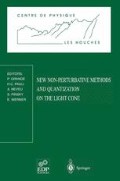Zusammenfassung
One of the fundamental questions that is open to both theory and experiment is how to observe the chiral phase transition. Indications that a phase transition from a chirally symmetric to a chirally broken phase have been obtained a long time ago: lattice gauge simulations of quantum chromodynamics (QCD), which are equilibrium calculations that can include only temperature but not finite density, show a phase transition at a finite critical temperature T c [1]. Unfortunately, due to the difficulties inherent in a confining theory such as QCD, it is impossible to observe this transition directly experimentally, let alone obtain experimental values for the usual quantities that are associated with critical phenomena, such as critical exponents.
Access this chapter
Tax calculation will be finalised at checkout
Purchases are for personal use only
Preview
Unable to display preview. Download preview PDF.
References
See for example, Laermann E., Nucl. Phys. A610 (1996) 1.
Klevansky S.P., Ogura A., and Hiifner J., Heidelberg Preprint HD-TVP-9702.
Klevansky S.P., Rehberg P., and Hüfner J., in preparation.
Schwinger J., J. Math. Phys. 2 (1961) 407.
Keldysh L.V., JETP 20 (1965) 1018.
Lifschitz E.M. and Pitajewski L.P., Physikalische Kinetik (Akademie Verlag, Berlin, 1986) p. 423.
See for example, Mröwczyriski S. and Heinz U., Ann. Phys. (N.Y.) 229 (1994) 1.
Kadanoff L.P. and Baym G., Quantum Statistical Mechanics (Benjamin / Cummings, Massachusetts, 1962) p. 110.
Klevansky S.P., Rehberg P., Ogura A., and Hüfner J., QCD Phase Transitions (GSI, Darmstadt, 1997) p. 397.
Rehberg P. and Hüfner J., Heidelberg Preprint HD-TVP-97/03
Author information
Authors and Affiliations
Editor information
Editors and Affiliations
Rights and permissions
Copyright information
© 1998 Springer-Verlag Berlin Heidelberg
About this paper
Cite this paper
Klevansky, S.P., Ogura, A., Rehberg, P., Hüfner, J. (1998). Developing Transport Theory to Study the Chiral Phase Transition. In: Grangé, P., Neveu, A., Pauli, H.C., Pinsky, S., Werner, E. (eds) New Non-Perturbative Methods and Quantization on the Light Cone. Centre de Physique des Houches, vol 8. Springer, Berlin, Heidelberg. https://doi.org/10.1007/978-3-662-08973-6_8
Download citation
DOI: https://doi.org/10.1007/978-3-662-08973-6_8
Publisher Name: Springer, Berlin, Heidelberg
Print ISBN: 978-3-540-64520-7
Online ISBN: 978-3-662-08973-6
eBook Packages: Springer Book Archive

